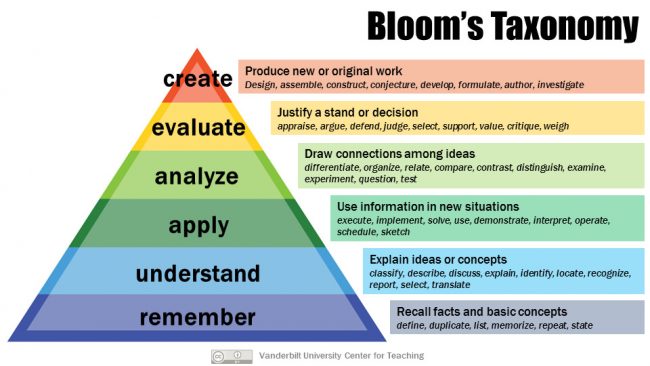21st-century skills (those are critical thinking, creativity, collaboration, communication, information and media literacy, and flexibility) are in focus these days. Teachers try to force and motivate students to work collaboratively while struggling to push extra time for productive practice into the lesson plan. There is one way to develop high-level thinking in the short class time — that is flipped classroom.
What is a Flipped Classroom?
The Flipped Classroom Approach is widely used in the lessons nowadays. ‘Flip’ stands for:
F- Flexible environment
L- Learning culture
I — Intentional content
P — Professional education
Now I will explain it in a different way. Take a look at Bloom’s Taxonomy — you can see it in the picture below. Traditionally, we move bottom-up, that is from lower-thinking skills (remembering, understanding and applying) to higher-thinking skills (analyzing, evaluating and creating). Due to the lack of time, we can’t go through all the stages within one lesson. That is why in a traditional classroom, students apply high-order thinking at home, which is not always effective. Read more about HOTs and LOTs in this article.

What a Flipped Classroom offers is to move classroom work to homework, and homework — to classwork. Students can study the theoretical material, as well as do mechanical tasks at home, and then apply them in the classroom. And our Blooms Taxonomy triangle will look as follows:

Make short of long, students will be able to use basic skills at home and use high-level skills in the classroom with the help of the Flipped Classroom. Read more about the Flipped Classroom in this article.
Why is flipped learning good for a student?
- It is a student-centred approach;
- Students receive immediate feedback (in case they study on the platform with automatical check-up);
- They receive assessment more often;
- Students get a chance to learn the topic deeply;
- Students study at their own pace;
- It boosts their confidence (students get ready at home and apply their knowledge in class);
- Students are given meaningful and real-life activities in the classroom.
How can we promote critical thinking in the Flipped class?
- Leave out the classroom tasks that promote lower-level thinking skills. These are the tasks, that start with such words as ‘describe’, ‘locate’, ‘identify’, etc. Use those that make students apply high-level ones: ‘construct’, ‘formulate’, ‘devise’, ‘analyze’, ‘compare’, etc.
- Use correct questions. Instead of asking “What”, “Where”, “When”, ask “What do you think”, “How would you support”, “What criteria”, “What alternative”, and so on.
- Make the materials meaningful. What is the sense of knowing such reading techniques as skimming and scanning, if a student cannot apply them with the authentic materials in a real-life situation? Give the task to read about the techniques at home, and make students apply these techniques in class with the authentic materials, such as newspaper articles, social media posts, reviews, advertisements, etc.
- Make the tasks and problems meaningful. Here is your chance to talk about things that worry students: depending on age, these could be games (including computer and mobile ones), film characters, cartoons, tales, stories, celebrities. Build up the discussions around students interests.
- Use PBL (project-based learning). The students will be able to solve a real-world problem and to apply the knowledge and skills they have and that they will need for life and work.






 Вероника Аветисян
Вероника Аветисян 
 Маргарита Аветисян
Маргарита Аветисян 


